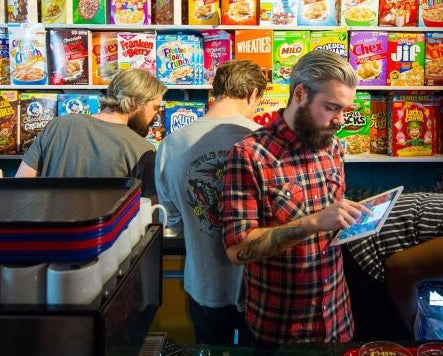A sugar tax is a good idea - but sinister marketing techniques are the real enemy in the battle against child obesity
But, you cry, what else can you give your child for breakfast? We don’t have time to be poaching eggs before the school run while simultaneously Pritt-sticking a forgotten class project

Their eyes don’t so much follow you around the room as gaze down at your children. Connecting with them, beseeching them to be given pride of place on the breakfast table. Really, they all do. Those rascally rogues, Snap, Crackle and Pop. The Honey Monster. Tony the Tiger. And, of course, that cheeky monkey, Coco. “Nonsense,” you murmur, “they’re looking into their bowls,” as you drag your little ones towards the toilet roll aisle, even while they scream, “Mummmeeee!” and reach for their new friends.
It sounds like a half-baked conspiracy theory, but next time you’re in the cereal aisle, check where every cereal-box character is looking. A 2014 study by Cornell University of 65 cereal brands in 10 different grocery stores found that, on average, characters had a downward gaze of 9.6 degrees on cereals marketed towards children. Not only that, but it found that children’s cereals were placed at about half the height of adult cereals. A related study found that brand trust was 16 per cent higher and the feeling of connection to the brand was 28 per cent higher when the character on the box made eye contact.
Sinister stuff, but then we know that marketing types use all kinds of tricks to make us buy their products. Supermarkets themselves are minefields. From the second we enter the door we are being manipulated, from the layout of the store to the positioning of items on shelves. That soft muzak you barely noticed? That comforting smell of fresh-baked bread? All there to make you relax into your surroundings, spend more time wandering the aisles, and ultimately buy more.
More expensive products will often be placed at eye height, with cheaper brands lower down. BOGOF deals, limited offers. Staples such as bread, eggs and milk at the back of the store. And let’s not forgot tillside temptation. Tesco recently pledged that all its tills would be sweet-free, replacing them with healthier snacks, but you are still not much more than arms reach from a family-sized Dairy Milk as you empty your basket.
Back to Coco and co. The Kelloggs character had the dubious honour of a parliamentary mention yesterday when MPs were discussing Jamie Oliver’s proposal for a sugar tax. He has been campaigning for a tax on sugary drinks, something he has been trialling in his own restaurants. After accusations of the Government trying to suppress the report on the proposal, a senior public health official went public with the findings, confirming that, yes, a sugar tax would help to curb childhood obesity. The recommendations went further, advising crackdowns on advertising of sugary foods - including the use of cartoon characters.
“The evidence is that things like those Coco Pop monkeys do engage children and affect food preference and choice,” said Dr Alison Tedstone of Public Health England.
Bravo, but how have we taken so long to get here? Yes, the world is awash with sugar-filled drinks and treats, but few of us are under any illusions that a gallon of fizzy pop has any health benefits. We have already cracked down on advertising food high in fat, salt or sugar during children’s programming (although not during prime time shows like The X Factor that often have a young audience).
But sugary cereals for years now have been marketed in a way to appeal to children, and to the parents desperately trying to feed them the right thing, as “high in vitamins and minerals”, “rich in fibre”, “a great source of energy”, and “the best start to the day”. A study by Action on Sugar earlier this year revealed that the most sugary cereals included Kellogg’s Frosties (theyyy’re grrreat! - apart from the 7tsp of sugar per 100g) and Coco Pops, with Nestle Cheerios and Weetabix Chocolately Weetos not far behind. While we would never allow Coca Cola to tell us it’s a great source of energy with a straight face, we have been spoon-fed weasel words by some of the best-known brands out there.
Perhaps that’s part of the problem. These are the brands we grew up with: they are safe and familiar and not a little nostalgic. So nostalgic, in fact, that when two brothers opened a cafe in London serving selections of sugary delights, it instantly attracted queues of breakfasting millennials.
Here, as you wait in line perusing the menu, you will hear exclamations of delight as memories are jogged. “Shreddies!” “Golden Grahams!” “Lucky Charms - we were never given those!” Diners can plump for the American option too; we don’t just identify with our own ‘British’ brands, Cap’n Crunch is also welcome in our nostalgic world. And yes, his gaze is distinctly downcast.
But, you cry, what else can you give your child for breakfast? We don’t have time to be poaching eggs before the school run while simultaneously combing Millie’s tangles and Prit-sticking a forgotten class project. Well, some proper porridge is a cinch in the microwave nowadays (despite what the purists say), or make your own muesli. And whatever you do, if you’re shopping with your children, stay out of the cereal aisle - and far away from those malevolent eyes.
Join our commenting forum
Join thought-provoking conversations, follow other Independent readers and see their replies
Comments